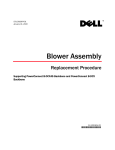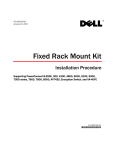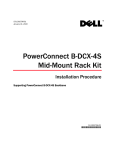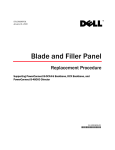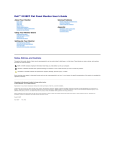Download Dell and XFP Optical Transceiver Replacement Procedure
Transcript
53-1001805-01 January 31, 2010 SFP, SFP+, and XFP Optical Transceiver Replacement Procedure 53-1001805-01 *53-1001805-01* Notes, Cautions, and Warnings NOTE A NOTE indicates important information that helps you make better use of your computer. CAUTION See the safety and regulatory information that shipped with your system. For additional regulatory information, see the Regulatory Compliance Homepage on www.dell.com at the following location: www.dell.com/regulatory_compliance. CAUTION A CAUTION indicates potential damage to hardware or loss of data if instructions are not followed. DANGER A DANGER indicates a potential for property damage, personal injury, or death. ____________________ Information in this document is subject to change without notice. © 2009 Dell Inc. All rights reserved. Reproduction of these materials in any manner whatsoever without the written permission of Dell Inc. is strictly forbidden. Trademarks used in this text: Dell, the DELL logo, Inspiron, Dell Precision, Dimension, OptiPlex, Latitude, PowerEdge, PowerVault, PowerApp, Dell OpenManage and the YOURS IS HERE logo are trademarks of Dell Inc.; Intel, Pentium, and Celeron are registered trademarks of Intel Corporation in the U.S. and other countries; Microsoft, Windows, Windows Server, MS-DOS and Windows Vista are either trademarks or registered trademarks of Microsoft Corporation in the United States and/or other countries. Other trademarks and trade names may be used in this document to refer to either the entities claiming the marks and names or their products. Dell Inc. disclaims any proprietary interest in trademarks and trade names other than its own. Regulatory Model Codes: Brocade DCX-4S, Brocade DCX 2 SFP, SFP+, and XFP Optical Transceiver Replacement Procedure 53-1001805-01 In this guide • Installing an SFP, SFP+, or XFP Optical Transceiver. . . . . . . . . . . . . . . . . . . . • Time required . . . . . . . . . . . . . . . . . . . . . . . . . . . . . . . . . . . . . . . . . . . . . . . . . . • Items required . . . . . . . . . . . . . . . . . . . . . . . . . . . . . . . . . . . . . . . . . . . . . . . . . • Removing a transceiver . . . . . . . . . . . . . . . . . . . . . . . . . . . . . . . . . . . . . . . . . . • Replacing a transceiver . . . . . . . . . . . . . . . . . . . . . . . . . . . . . . . . . . . . . . . . . . 3 3 3 4 4 Installing an SFP, SFP+, or XFP Optical Transceiver NOTE The XFP transceivers are used only with the FC10-6 port card. Switches and blades that employ transceivers typically have them arranged in two rows, back to back. On most switches and the DCX-4S Backbone, that means that the bottom row of transceivers is upside down in relation to the top row. Time required The replacement procedure for an SFP or XFP takes less than five minutes. Items required • Replacement SFP, SFP+, or XFP • Optical transceiver extraction tool Most Brocade switches and backbones come with a transceiver extraction tool (Figure 1) and holster. The extraction tool is designed to remove transceivers from switches and blades where the space is limited. FIGURE 1 Optical transceiver (SFP, SFP+, and XFP) extraction tool SFP, SFP+, and XFP Optical Transceiver Replacement Procedure 53-1001805-01 3 Removing a transceiver 1. Remove any cables that are inserted into the transceiver. Use the extraction tool to open the cable latching mechanism. 2. Pull the bail (wire handle) away from its pivot point and out, sliding the transceiver out of the switch or blade (Figure 2). ! 1 1 SFP/XFP bail FIGURE 2 Installing an optical transceiver in the upper row of port slots Replacing a transceiver 1. Position the optical transceiver so that the key is oriented correctly to the port. Insert the transceiver into the port until it is firmly seated and the latching mechanism clicks. Transceivers are keyed so that they can only be inserted with the correct orientation. If a transceiver does not slide in easily, ensure that it is correctly oriented. 2. Position a cable so that the key (the ridge on one side of the cable connector) is aligned with the slot in the transceiver. Insert the cable into the transceiver until the latching mechanism clicks. Cables are keyed so that they can be inserted in only one way. If a cable does not slide in easily, ensure that it is correctly oriented. 4 SFP, SFP+, and XFP Optical Transceiver Replacement Procedure 53-1001805-01




